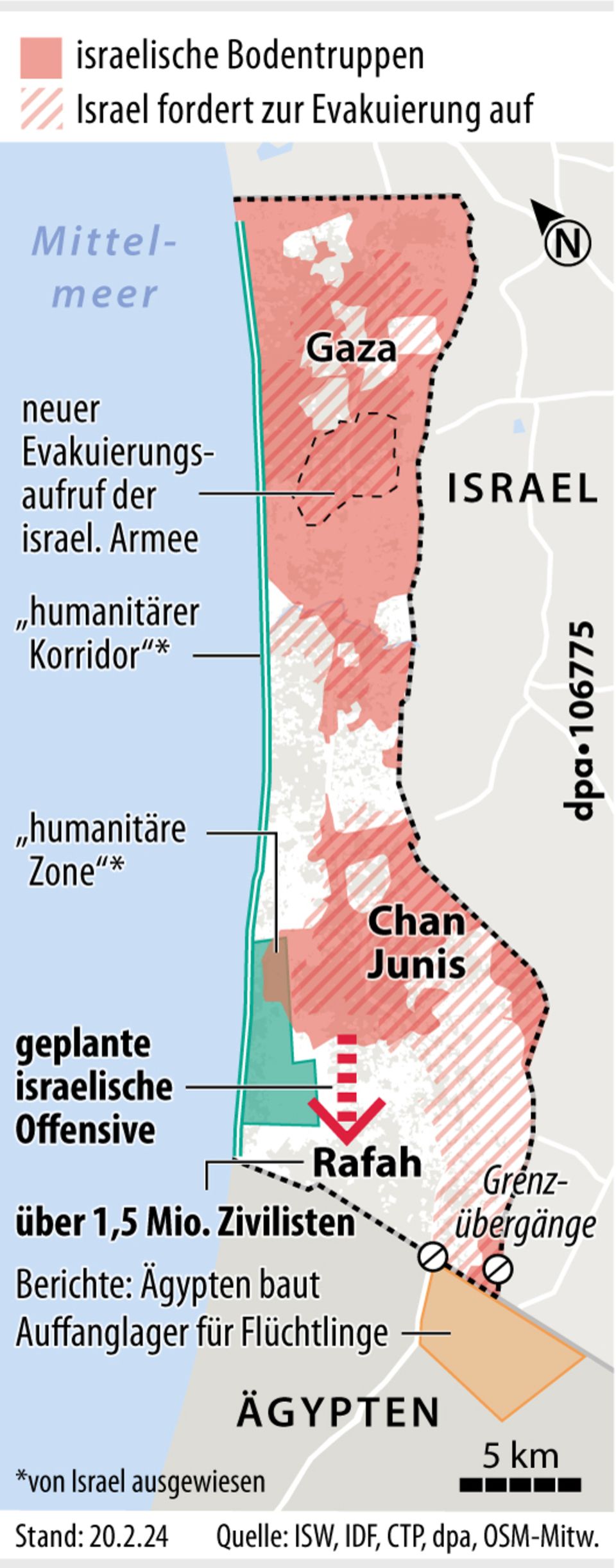A ground offensive is expected in Rafah in the south of the Gaza Strip. Now the Israeli government has presented a plan for the evacuation of civilians.
Ahead of the expected ground offensive in Rafah in the southern Gaza Strip, the Israeli army has presented a plan for the evacuation of civilians from combat zones. The military submitted to the Israeli war cabinet “a plan for the evacuation of the population from combat areas in the Gaza Strip and the further operational plan,” as the office of Prime Minister Benjamin Netanyahu announced on Monday.
More than 1.4 million people have fled to the city of Rafah, which borders Egypt, since the Israeli military offensive in the Gaza Strip began. The Israeli army says it is preparing a ground offensive there to destroy the “last remaining Hamas bastions” and free hostages suspected to be there. The government did not provide precise information on Monday about how and when civilians would be evacuated.

Rafah: Observers warn of devastating consequences of a ground offensive
Netanyahu has repeatedly stated that he will stick to the planned ground offensive despite international criticism. “Early next week I will convene the cabinet to approve operational plans for Rafah, including the evacuation of civilians,” the prime minister said at the weekend. Observers warn of the devastating consequences of a ground offensive for the civilian population.
Netanyahu emphasized in an interview with the US television station CBS on Sunday that a possible agreement on a ceasefire with the Islamist Palestinian organization Hamas would “a little delay” such a military operation, but it will happen. He said: “It must be done because complete victory is our goal and complete victory is within reach – not in months but in a few weeks when we begin the operation.”
Mediation efforts by Egypt, Qatar and the USA for a new ceasefire in the Gaza Strip are in full swing. According to an Egyptian media report, talks were held in Doha on Sunday, with representatives of the Israeli government and Hamas also present. Negotiators have expressed hope that a temporary ceasefire and the release of hostages could be achieved before the start of Ramadan on March 10 or 11.
The Gaza war was triggered by the major attack on Israel on October 7th by Hamas, which the EU and the USA classify as a terrorist organization. Islamist fighters committed atrocities primarily against civilians. According to Israeli information, around 1,160 people were killed and around 250 hostages were taken to the Gaza Strip.
According to Israeli information, 130 hostages are still in the Palestinian territory, 31 of them are dead. The Israeli army confirmed on Sunday the death of a 19-year-old soldier who was killed on the day of the attack and whose body is still in the Gaza Strip located.
In response to the Hamas attack, Israel has since taken massive military action in the Gaza Strip, with the declared aim of destroying Hamas. According to Hamas figures, which cannot be independently verified, more than 29,690 people have been killed in the Palestinian territory since then. According to Hamas, 15 members of a family were killed in the city of Gaza on Monday night.
Gaza Strip
Behind a dune, at the border crossing, begins a tunnel large enough for cars
Foreign Minister Annalena Baerbock (Greens) again emphasized on Sunday the need for a two-state solution to secure peace in the region. The people in Israel could only live in security if the Palestinians also lived in security, she said on the ARD program “Report from Berlin”. That’s why Germany is working with its partners “in the light of this great catastrophe” on a path to peace, “where the security of one means the security of the other,” she emphasized.
Source: Stern
I have been working in the news industry for over 6 years, first as a reporter and now as an editor. I have covered politics extensively, and my work has appeared in major newspapers and online news outlets around the world. In addition to my writing, I also contribute regularly to 24 Hours World.




